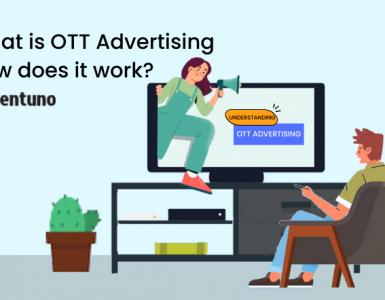OTT platforms have become very popular these days. Using Netflix, Roku, Amazon Prime, etc. is now synonymous with watching shows, movies, videos or any video content one wants to watch.
As OTT grows to become the more preferred platform for viewers, OTT advertising has grown to become a lucrative marketing medium for businesses too. According to a Forbes report, OTT ad spends is expected to reach almost USD 15 billion by 2023. The continuous increase in the number of subscribers and viewers has created big opportunities for brands to find their target audience here.
In this article, you will understand all about OTT advertising and why businesses are shifting towards it. You will get answers to the following:
Table of Contents :
2. Why are OTT ads becoming popular?
3. Benefits of OTT Advertising
4. Distribution Channels for OTT ads
6. Challenges of OTT advertising
1. What Is OTT Advertising?
OTT or Over-the-top advertisements are ads that are delivered while streaming video content.
OTT advertising is advertising on Smart TV and connected TV devices. Any advertising that happens, for example, on Roku or Samsung TV is OTT Advertising.
The term OTT or Over-the-top means bypassing traditional forms of broadcasting, without having to follow strict schedules or be limited geographically. It gives content providers and businesses an opportunity to reach customers any time and anywhere, through the internet.
OTT ads offer businesses, big and small, a large potential to grow their businesses with great exposure and tremendous returns.
2. Why Are OTT Ads Becoming Popular?
CTV ad spend grew to $15.2 billion in 2021, a 57% increase from 2020, and is projected to expand another 39% in 2022, hitting $21.2 billion. That will more than double the 2020 CTV ad spend. What is causing this tumultuous growth worldwide?
The OTT streaming industry of course. The exponential increase in viewership of OTT platforms is creating huge opportunities for advertisers to make an obvious shift towards them to capture large audiences. This, along with the hoard of other benefits that OTT advertising brings for the advertiser as well as the viewer.
Let’s have a look at the growth trends in the OTT streaming industry.
- The global digital TV and film revenues are expected to $159 billion by 2024.
- SVOD revenues are expected to climb up to USD 87 billion by 2024.
- According to a study by Roku, 73% of the viewers do not mind watching ad-supported video-on-demand (AVOD)
- China and the USA are expected to control 56% of the global OTT revenues.
3. Benefits of OTT Advertising
OTT advertising has come as a disruptive force for the TV commercial industry. Its viability comes from several advantages it offers over traditional TV ads:
Scalability
The proportion of U.S. households that have video streaming services is 86%. This means there are now 110.2 million US households accessing streaming services, as of March 2022
OTT advertisers are reaping the benefits of showcasing to this larger audience as well. Going by the economies of scale, a business can achieve a much more efficient customer acquisition ratio as compared to TV commercials.
Better Targeting
Ads can be targeted to different individuals based on their personal areas of interest. The data of any individual is collected in various ways like search history, preferences given by the user, past activities, location, etc. Showcasing more relevant ads to each individual helps optimize costs and avoid redundancy of ad spends on the wrong audience.
Higher CPM rates
Advertisers are ready to pay higher CPM rates because user engagement is more owing to larger screens and niche targeting.
Better Engagement
An average completion rate of 98% has been recorded for OTT ads. This means that almost 98% of the customers have watched the ad from start to end.
Users are clicking to watch a particular video, and there is no autoplay involved. So they will have more concentration while watching the ad. This is different from TV ads where the live stream keeps playing and the viewer might be working on something else.
Better Analytics
OTT ads provide for constructive data collection for businesses through ad views, web and mobile downloads, and sales. Advertisers are able to understand the success of any marketing campaigns through the various metrics like Video Completion Rate (VCR) or Gross Rating Points (GRP). This helps in optimizing future ad campaigns based on current engagement.
You can get a better understanding of your ad engagement through likes and dislikes, watch history, location, etc. In cable TV, the whole family might be watching together, so analytics is difficult.
4. Distribution Channels for OTT ads
Businesses that advertise through OTT videos, opt for any of the following platforms for their ads:
- Ad-supported Video-on-demand – Crackle, Tubi, Vudu, etc.
- Connected TV – Roku, Amazon Firestick, etc.
- Multichannel Video Programming Distributors – AT&T Now, Sling, YouTube TV, etc.
Without getting into much detail about each type of channel, we would like to highlight the most popular ones for you.
Roku OTT ads
Roku is one of the most widely used platforms with almost 60 million subscribers, the world over. It has made its footprints by being game-changers in the OTT landscape.
Along with interactive video, overlays, and sponsorships, their ad platforms allow advertisers to display 15 to 30-second spot ads.
Hulu OTT ads
Having gathered around 29 million subscribers in 2019 alone, Hulu is the second-largest streaming service provider.
Its ad platform offers various options for bidding, targeting, measuring amongst the different types of ads one can choose from.
Tubi OTT ads
Tubi TV is another leading OTT service providing platform, with around 250+ content providing partners. With an audience of about 25 million subscribers in 2019, Tubi TV is seen to be treading close to other popular OTT platforms like Roku and Hulu.
Just like Roku, Tubi TV allows users 15 to 30-second ad spots, without giving the viewer an option to skip the ad. Its ad platform works on advanced technologies for targeting and measurement of ads.
5. How does OTT advertising work?
OTT advertising is a very specific, customer-focused marketing activity. Here, the ads are displayed to the customers based on their preferences and past behavior. This data is stored and available with the OTT platforms.
Businesses that want to advertise through an OTT platform, share their ad content and information with the platform through one of the two types of tags:
- VAST or Video Ad Serving Template Tags
- VPAID or Video Player-Ad Interface Definition Tags
These tags are submitted by the advertisers with information like the target audience, how the ads need to be displayed, for how long the ads need to play, etc. Additionally, the brands also decide on the ad-insertion method, which could be:
CSAI or Client Side Ad Insertion
CSAI is the traditional form of ad insertions, where the ads are called by the ad server and displayed to the viewer. There is a small pause or break in the video content, while the ad server pulls up the desired ad and serves it to the user’s device.
In case the user’s device has ad blockers turned on, the ads may not get played.
SSAI or Server-side Ad Insertion
SSAI is different from CSAI and does not require ads to be pulled up by an ad server. Rather, the ads are already stitched into the content and are played along with the video content.
In this method, ad blockers cannot stop the ads from getting played as they are already a part of the video content.
The ad selection, insertion, and display process take place in the following sequence:
- The audience or target viewer profile is created.
- Campaigns are pushed on the platforms.
- Ads are displayed based on the tag selected by the advertiser.
- OTT operator gets back to advertisers with the campaign’s performance results.
6. Challenges of OTT advertising
OTT advertising has been considered as a boon to many businesses, big or small, for its vast range of benefits. However, there could be some challenges involved that are yet to be addressed.
Unregulated segment
OTT advertising is a relatively new concept in the marketing industry with not many regulations in place to control it. Lack of stringent regulations could cause trouble in some cases. For example, fraudulent or malicious ads being displayed to viewers.
Ad fraud losses are estimated to be around USD 35 billion in 2019 alone. Few of the biggest OTT players like Roku and Hulu are working together to curb this enormous threat.
Advertiser-Platform Relations
Currently, the only people with access to OTT ad controls are Smart TV manufacturers and OTT service providers. Therefore, businesses could find it disappointing where their ads are not given approval. This could tarnish relations with big advertisers on repeated rejections by the platforms.
Incomplete information
Though OTT advertising provides reach to the masses, there’s still a lot of undisclosed information to businesses. There are several metrics in place that can help you optimize your ads better every time. However, not enough information is available to understand who your ads are reaching, how well it’s doing, or if you need to change the demographic.
For example, click-through-rates cannot be measured as users cannot click on the advertisement to reach the business’ page.
Not all platforms allow ads
The growing OTT TV market is creating huge opportunities for advertisers to reach larger audiences. However, not all platforms allow advertisers on their platform.
7. Future of OTT advertising
Given the merits that OTT advertising brings along with it and the ever-growing OTT segment, it is a no-brainer that OTT advertising is one of the best ways to reach your customers, even in the future. OTT ads are becoming an integral part of marketing plans and budgets for most businesses.
Viewers are ditching traditional television to get more engaged with internet-powered platforms and devices. This is what the future will continue to look like too. OTT streaming is just the beginning of this revolutionary shift.
It is best for businesses to hop onto the bandwagon and make OTT advertising a part of their business growth. It will open up unprecedented windows of opportunities for targeting new audiences.
Looking to monetize your content with ads? Use our video ad server to run multiple campaigns, and track analytics. We support VAST, VPAID, programmatic tags. You can run video, display, native, and interstitial ads.
What are your thoughts on this article? reach out to us at info@ventunotech.com if you would like to discuss!
Looking to launch your own streaming service?









